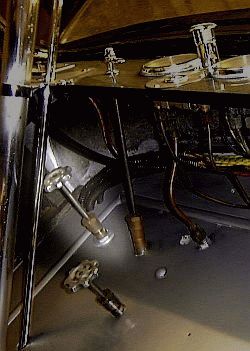
firing up valve located under the dash and to the right of the steering column
The firing up valve is used when the car is initially steamed up. After the pilot is lit the burner vaporizer is usually too cold for vaporization of the kerosene the burner normally uses. The burner forks are heated with the torch while heating the pilot vaporizer. Once the pilot is lit and has burned for a few minutes the firing up valve is opened to permit the easy to vaporize pilot fuel to the burner. As the pilot fuel vaporizes easy it allows the cold burner to ignite quickly with little danger of a burner backfire. The firing up valve is left open for a few minutes to insure the burner vaporizer is good and hot and then it is closed and the burner fuel valve opened to admit kerosene to the burner so that steam can be generated.
The second use for the firing up valve is to relight the burner after the car has been sitting for a while. When a Stanley car has been sitting for a period of time (typically anything longer than 15 to 20 minutes) with the burner shut down the vaporizer tube will cool. If the burner valve is opened to relight the burner the liquid fuel hits the vaporizer and cools it even more. Liquid fuel ends up being discharged from the burner nozzles into the mixing tubes where it lays. When enough vapors are emitted that the pilot can light them the burner backfires and burning of the raw fuel happens in the mixing tubes. Just as was done when the car was initially fired up, the firing up valve is first opened for a short period of time to light the burner and heat the vaporizer prior to the burner valve being opened for kerosene to be burned.